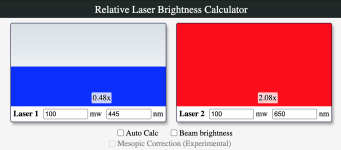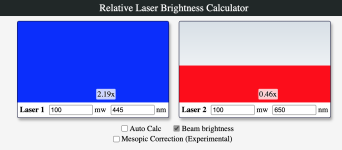julianthedragon
Well-known member
- Joined
- Jun 3, 2020
- Messages
- 369
- Points
- 63
Here is an illustration of what I mean:
Take a 445nm and 650nm of the same power.
|445 - 555| = 110nm while |650 - 555| = 95nm, so one would expect the one closer to the 555nm peak in visibility to be brighter as seen below.

However, checking off beam brightness with the same settings shows the following:

Is there a reason for this? Is it because of human perception? Rayleigh scattering? Red light carrying "less energy" due to its longer wavelength?
I've noticed in person too that the beam from 30mw 450nm is more visible than 50mw at 635nm.
P.S. I did google this question and search on LPF before I asked believe it or not
Take a 445nm and 650nm of the same power.
|445 - 555| = 110nm while |650 - 555| = 95nm, so one would expect the one closer to the 555nm peak in visibility to be brighter as seen below.

However, checking off beam brightness with the same settings shows the following:

Is there a reason for this? Is it because of human perception? Rayleigh scattering? Red light carrying "less energy" due to its longer wavelength?
I've noticed in person too that the beam from 30mw 450nm is more visible than 50mw at 635nm.
P.S. I did google this question and search on LPF before I asked believe it or not





